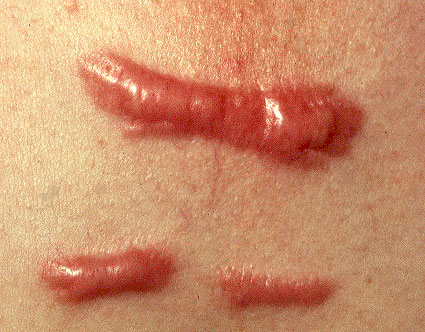|
|
|
Keloids and hypertrophic scars
(ke'loid) (Greek. Kele - tumor (crab claw) + eidos - similar to)
A keloid is an elevated progressive scar formation without regression.
Unlike hypertrophic scars, keloids can develop without an apparent precursor trauma. Also, unlike hypertrophic scars, which typically thicken for months, keloids can continue to grow for many years.
Keloid and hypertrophic scar are related. They are both proliferations of fibroblasts.
Keloids can occur, unlike hypertrophic scars, at sites of minimal or apparently no injury to skin. Unlike hypertrophic scars, keloids can continue to expand for many years. Areas prone to keloid formation include the upper chest and back and external ears. Blacks appears to be more prone to keloid formation than whites.
Hypertrophic scars occur after trauma, frequently surgical, or other disease state such as acne vulgaris. Hypertrophic scars typically will enlarge for three to six months post-surgery. They then peak in size as red raised nodules and begin to involute. Hypertrophic scars are much more common than true keloids.
Treatment:
- Intralesional triamcinolone diacetate 10-20 mg/ml repeated every eight weeks can produce a significant improvement of keloids.
- If lesions are very large, surgical excision followed by intralesional triamcinolone to prevent recurrence can be effective treatment. Similarly, after surgical removal of a keloid, pressure can sometimes prevent recurrences.
- Occasionally, after multiple treatment failures with more standard therapy, radiation therapy post-surgery may be indicated.
- Hypertrophic scars respond well to time alone.
- If these lesions are symptomatic or growing quite substantially, intralesional triamcinolone diacetate 10 mg/ml at 8 weekly intervals can speed the flattening of these lesions.
- Should surgical removal of keloids or hypertrophic scars be contemplated, care should be taken to treat the wound area as gently as possible. Close monitoring is required post-surgery so that aggressive local therapy with steroid injections can be implemented before a recurrence develops.
Treatment Specifically for Keloid Scars:
- Silicone gel or silicone sheeting gives modest benefit
- Intra-lesional Interferon, Alfa-2b
- Laser including pulse dye laser, argon laser and Nd:YAG laser
- Post-operative use of Imiquimod cream shows promise in early trials

Back to Dermatology Glossary - K Index |
Back to Dermatology Glossary Index
|